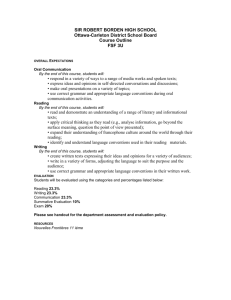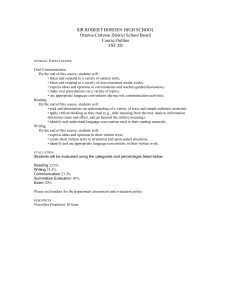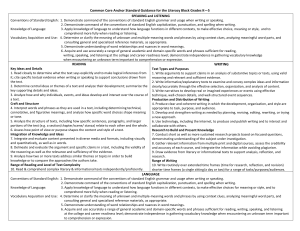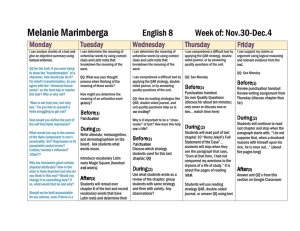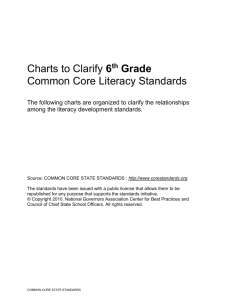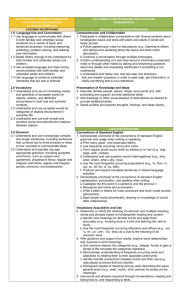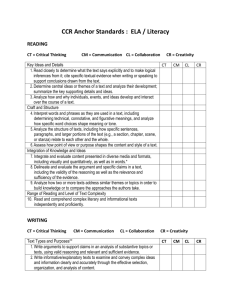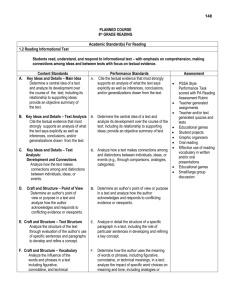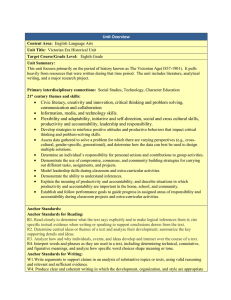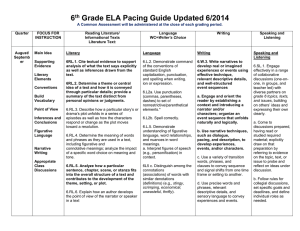Literatue of Self Discovery
advertisement
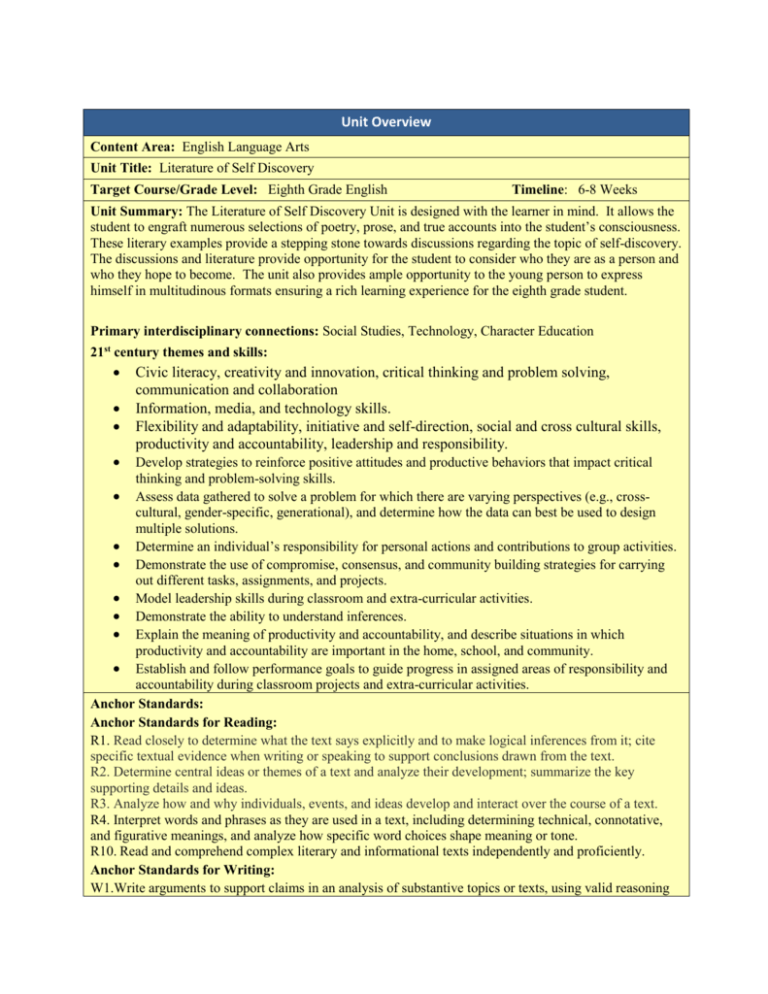
Unit Overview Content Area: English Language Arts Unit Title: Literature of Self Discovery Target Course/Grade Level: Eighth Grade English Timeline: 6-8 Weeks Unit Summary: The Literature of Self Discovery Unit is designed with the learner in mind. It allows the student to engraft numerous selections of poetry, prose, and true accounts into the student’s consciousness. These literary examples provide a stepping stone towards discussions regarding the topic of self-discovery. The discussions and literature provide opportunity for the student to consider who they are as a person and who they hope to become. The unit also provides ample opportunity to the young person to express himself in multitudinous formats ensuring a rich learning experience for the eighth grade student. Primary interdisciplinary connections: Social Studies, Technology, Character Education 21st century themes and skills: Civic literacy, creativity and innovation, critical thinking and problem solving, communication and collaboration Information, media, and technology skills. Flexibility and adaptability, initiative and self-direction, social and cross cultural skills, productivity and accountability, leadership and responsibility. Develop strategies to reinforce positive attitudes and productive behaviors that impact critical thinking and problem-solving skills. Assess data gathered to solve a problem for which there are varying perspectives (e.g., crosscultural, gender-specific, generational), and determine how the data can best be used to design multiple solutions. Determine an individual’s responsibility for personal actions and contributions to group activities. Demonstrate the use of compromise, consensus, and community building strategies for carrying out different tasks, assignments, and projects. Model leadership skills during classroom and extra-curricular activities. Demonstrate the ability to understand inferences. Explain the meaning of productivity and accountability, and describe situations in which productivity and accountability are important in the home, school, and community. Establish and follow performance goals to guide progress in assigned areas of responsibility and accountability during classroom projects and extra-curricular activities. Anchor Standards: Anchor Standards for Reading: R1. Read closely to determine what the text says explicitly and to make logical inferences from it; cite specific textual evidence when writing or speaking to support conclusions drawn from the text. R2. Determine central ideas or themes of a text and analyze their development; summarize the key supporting details and ideas. R3. Analyze how and why individuals, events, and ideas develop and interact over the course of a text. R4. Interpret words and phrases as they are used in a text, including determining technical, connotative, and figurative meanings, and analyze how specific word choices shape meaning or tone. R10. Read and comprehend complex literary and informational texts independently and proficiently. Anchor Standards for Writing: W1.Write arguments to support claims in an analysis of substantive topics or texts, using valid reasoning and relevant and sufficient evidence. W4. Produce clear and coherent writing in which the development, organization, and style are appropriate to task, purpose, and audience. W5.Develop and strengthen writing as needed by planning, revising, editing, rewriting, or trying a new approach. W6. Use technology, including the Internet, to produce and publish writing and to interact and collaborate with others. W9. Draw evidence from literary or informational texts to support analysis, reflection, and research. W10. Write routinely over extended time frames (time for research, reflection, and revision) and shorter time frames (a single sitting or a day or two) for a range of tasks, purposes, and audiences. Anchor Standards for Speaking and Listening: SL.1.Prepare for and participate effectively in a range of conversations and collaborations with diverse partners, building on others’ ideas and expressing their own clearly and persuasively. Sl.6. Adapt speech to a variety of contexts and communicative tasks, demonstrating command of formal English when indicated or appropriate. Anchor Standards for Language: L1. Demonstrate command of the conventions of standard English grammar and usage when writing or speaking. L2. Demonstrate command of the conventions of standard English capitalization, punctuation, and spelling when writing. L3. Apply knowledge of language to understand how language functions in different contexts, to make effective choices for meaning or style, and to comprehend more fully when reading or listening. L4. Determine or clarify the meaning of unknown and multiple-meaning words and phrases by using context clues, analyzing meaningful word parts, and consulting general and specialized reference materials, as appropriate. L5. Demonstrate understanding of figurative language, word relationships, and nuances in word meanings. L6. Acquire and use accurately a range of general academic and domain-specific words and phrases sufficient for reading, writing, speaking, and listening at the college and career readiness level; demonstrate independence in gathering vocabulary knowledge when considering a word or phrase important to comprehension or expression. Learning Targets/Activities Domain: Reading Literature, Writing, Speaking and Listening, Language Cluster: Key Ideas and Details, Craft and Structure, Range of Reading and Level of Text Complexity, Text Types and Purposes*, Production and Distribution of Writing, Research to Build and Present Range of Writing Knowledge, Comprehension and Collaboration, Presentation of Knowledge and Ideas, Conventions of Standard English, Knowledge of Language, Vocabulary Acquisition and Use Standard # Standards Cite the textual evidence that most strongly supports an analysis of what the text says RL.8.1. explicitly as well as inferences drawn from the text. Determine a theme or central idea of a text and analyze its development over the course of RL.8.2. the text, including its relationship to the characters, setting, and plot; provide an objective summary of the text. Analyze how particular lines of dialogue or incidents in a story or drama propel the action, RL.8.3. reveal aspects of a character, or provoke a decision. Determine the meaning of words and phrases as they are used in a text, including RL.8.4. figurative and connotative meanings; analyze the impact of specific word choices on meaning and tone, including analogies or allusions to other texts. RL.8.10 SL.8.1 SL.8.6 By the end of the year, read and comprehend literature, including stories, dramas, and poems, at the high end of grades 6–8 text complexity band independently and proficiently Engage effectively in a range of collaborative discussions (one-on-one, in groups, and teacher- led) with diverse partners on grade 8 topics, texts, and issues, building on others’ ideas and expressing their own clearly. Adapt speech to a variety of contexts and tasks demonstrating command of formal English when indicated or appropriate. W.8.1. Write arguments to support claims with clear reasons and relevant evidence. W.8.4. Produce clear and coherent writing in which the development, organization, and style are appropriate to task, purpose, and audience With some guidance and support from peers and adults, develop and strengthen writing as needed by planning, revising, editing, rewriting, or trying a new approach, focusing on how well purpose and audience have been addressed. Use technology, including the Internet, to produce and publish writing and present the relationships between information and ideas efficiently as well as to interact and collaborate with others. W.8.5. W.8.6. W.8.9 W.8.10. L.8.1. L.8.2. L.8.3. L.8.4. L.8.5 Draw evidence from literary or informational texts to support analysis, reflection, and research. Write routinely over extended time frames (time for research, reflection, and revision) and shorter time frames (a single sitting or a day or two. Demonstrate command of the conventions of standard English grammar and usage when writing or speaking. Demonstrate command of the conventions of standard English capitalization, punctuation, and spelling when writing. Use knowledge of language and its conventions when writing, speaking, reading, or listening. Determine or clarify the meaning of unknown and multiple-meaning words or phrases based on grade 8 reading and content, choosing flexibly from a range of strategies. Demonstrate understanding of figurative language, word relationships, and nuances in word meanings. L.8.6. Acquire and use accurately grade-appropriate general academic and domain-specific words and phrases; gather vocabulary knowledge when considering a word or phrase important to comprehension or expression. Unit Essential Questions Unit Enduring Understandings What does it mean to “come of age”? How do I find my place in the world of the 21st century? How are the struggles and triumphs of adolescence both personal and universal? How does an individual’s command of the English language influence others’ perceptions Literature and expressing one’s self through writing can allow one to reflect and bring meaning to the process of self-discovery. Personal growth is achieved through selfexamination and informed choices. Good writers determine which conventions of language most clearly and effectively of him or her? communicate their thoughts and ideas to the reader. Unit Learning Targets Students will ... RL.8.1 –Analyze text using textual evidence to support thesis in writing. RL.8.2-Determine theme through analyzing the central idea of a text as determined by the events that occur within the text. RL.8.3-Analyze the connections made in a text. RL.8.4- Utilize context clues and prior knowledge to extend vocabulary while comparing and contrasting to other texts. Read to understand and analyze events [RL.8.10] SL 8.1-Collaborate with the students in flexible groupings to discuss the text and topics related to the text, particularly as they relate to the student, other texts and world events. SL 8.6 - Deliver an appropriate speech using specific pre-determined requirements W.8.1-Create an original character analysis using textual evidence to support claims. W.8.4-Write clearly to specific requirements keeping audience in mind. W. 8.5-Revise and edit writing focusing on improvement as directed W.8.6-Use technology as necessary to produce, revise, and edit writing tasks as well as collaborate with peers and teacher. W.8.9-Use textual evidence from literary and/or informational texts to support analysis in any and all formats. W.8.10-Regularly compile samples of writing whose topics are chosen by student or teacher. L.8.1-Students identify and adjust to audience when writing and speaking L.8.2- Students will know when to use commas, ellipses, and dashes in their writing. L.8.2- Students will use correct spelling. L.8.4-Students will use the following strategies to determine or verify word meanings: • context clues • Greek or Latin affixes or roots • reference materials (dictionary, thesaurus, glossary) L.8.5-Students will recognize and interpret figures of speech such as verbal irony and puns. L.8.5-Students will use word relationships to deepen comprehension of individual words L.8.5-Students will examine and distinguish the connotations of words with similar meanings. L.8.6- Students will build a working vocabulary of grade-appropriate and academic language. Learning Activities Text Analysis Poetry Analysis Song Analysis Writing Good Leads Writing Using Imagery Paragraph Development Using Transitions Identifying Characters Using Quotes from Idioms Combining Sentences for Fluency Organization of Plot Determining Theme Responding To Writing Prompts Recognizing Allusion Recognizing Theme The Hot Seat-Interview Activity the Novel (s) Decoding Figurative Language Properly Using Textual Evidence Peer Conferences Writing a Proper Thesis Statement Writing Conferences Sequence of Events Word Study and Vocabulary building Evidence of Learning Formative Assessments Quizzes Writing Response Journal Two Minute Personal Speech Group Discussions Reading Response Journals Quick Writing Response/Share Poetry Response Short Personal Responses (One Word That Describes Me, A Time I Felt Like an Outsider, Writing Response Journals A Poem for Two Voices Found Poem-Stargirl Summative Assessments Who Are You Project Part One Novel Test (multi-format) Character Analysis Essay RESOURCES/TECHNOLOGY Teacher Instructional Resources: The Outsidersby S.E. Hinton Stargirl by Jerry Spinelli Novel Units Teacher Guide-The Outsiders Enotes Teacher Guide- The Outsiders Discovering Literature Series- The Outsiders Teacher Created Resources Guide- The Outsiders “S.E. Hinton Reflects on The Outsiders”-(article) “To Heal A Nation”-John L. Swerdlow-(article) A Short Biography of S.E. Hinton A Short Biography of O Henry A Short Biography of Jerry Spinelli Sadler-Oxford Vocabulary Short Story Resources: “Shaving”-Leslie Norris “Gentleman of Rio En Medio”-Juan A. A. Sedillo “A Retrieved Reformation”-O Henry “The Ransom of Red Chief”-O Henry Poetry Resources: “Nothing Gold Can Stay”-Robert Frost “The Road Less Travelled”-Robert Frost “Mirror”-Sylvia Plath “Pony Boy”-Bruce Springsteen “Poem for an Old Man”-Floris Clark McLaren “Thumbprint”-Eve Merriam Integration of Technology: Powerpoint; Smartboard; Elmo; Internet Technology Resources: Click the links below to access additional resources used to design this unit: Websites http://www.webenglishteacher.com/ http://owl.english.purdue.edu/ http://www.sadlier-oxford.com/ http://dictionary.reference.com/ http://www.kellygallagher.org/ Opportunities for Differentiation: Selective Grouping Modeling of Writing Techniques Books on CD Abbreviated Assessments Various Questioning/Discussion Techniques Previewing Literature Extended Time Teacher Notes: This is by no means a comprehensive compilation of activities and/or objectives; however, this unit does give an ambitious sampling of what occurs during the unit and should be adjusted to meet the individual students’ needs as well as teachers’ strengths.

